Greetings, fellow food enthusiasts! Today, I am thrilled to introduce you to the wonderful world of whole grains. These versatile ingredients not only bring a delightful burst of flavor to your dishes but also offer a plethora of health benefits. Whether you’re a seasoned chef or a kitchen novice, incorporating whole grains into your diet is a simple, enjoyable way to elevate your meals and nourish your body.
As someone who understands the importance of balanced nutrition, I have curated over 100 delicious recipes in my latest cookbook, “The Whole Grain Promise.” Each recipe showcases the natural goodness of whole grains, ensuring that you can savor every bite while supporting your well-being. From comforting classics to exciting new creations, these recipes have been crafted with care and passion.
Key Takeaways:
- Celebrate whole grains by incorporating them into your meals for a tasty and nutritious experience.
- Whole grains offer a wide range of health benefits, including heart health, weight management, and overall well-being.
- Cooking with whole grains is easy and enjoyable, with my cookbook providing a variety of simple and delicious recipes.
- You can enjoy whole grain dishes for every meal, from hearty breakfasts to satisfying dinners.
- Explore different whole grain varieties to add excitement and diversity to your culinary repertoire.
The Health Benefits of Whole Grains
Whole grains are a powerhouse of nutrients. They are rich in fiber, vitamins, and minerals, making them an essential part of a healthy diet. Incorporating whole grains into your meals offers numerous benefits for your overall well-being.
Fiber-Rich and Nutrient-Dense
Whole grains are packed with dietary fiber, which is essential for a healthy digestive system. It aids in maintaining regular bowel movements, preventing constipation, and improving gut health. Additionally, whole grains contain a wide range of vitamins and minerals, including folate, thiamin, niacin, iron, and magnesium, all of which are vital for proper body function.
Reduced Risk of Heart Disease
“Studies have shown that consuming whole grains can significantly reduce the risk of heart disease.”
Eating whole grains has been linked to a lower risk of heart disease. The fiber content helps lower cholesterol levels and promotes healthy blood pressure, which are key factors in reducing cardiovascular risk. Including whole grains in your diet can contribute to a healthier heart and a lower risk of heart-related issues.
Weight Management Support
If you’re looking to manage your weight, whole grains can be a valuable ally. The high fiber content in whole grains helps you feel fuller for longer, reducing the chances of overeating and aiding in weight control. Additionally, whole grains have a lower glycemic index compared to refined grains, which means they release energy more slowly, resulting in sustained energy levels and reduced cravings.
Overall Health Promotion
The benefits of whole grains extend beyond heart health and weight management. Research suggests that whole grain consumption is associated with a reduced risk of type 2 diabetes, certain types of cancer (such as colorectal cancer), and stroke. Whole grains also provide antioxidants and phytochemicals that have anti-inflammatory properties, contributing to overall well-being and longevity.
To fully reap the benefits of whole grains, aim to incorporate a variety of them into your diet. Some popular options include:
- Whole wheat
- Oats
- Brown rice
- Quinoa
- Barley
- Millet
- Buckwheat
Experiment with different whole grains to discover your favorites and enjoy the wide range of flavors and textures they offer.
| Benefit | Explanation |
|---|---|
| High in Fiber | Fiber aids digestion and promotes a healthy gut. |
| Heart Health | Whole grains reduce the risk of heart disease. |
| Weight Management | Whole grains help you feel fuller for longer, supporting weight control efforts. |
| Prevention of Chronic Diseases | Consuming whole grains is associated with a reduced risk of type 2 diabetes, certain cancers, and stroke. |
Incorporating whole grains into your daily meals is not only beneficial for your health but also adds delicious flavors and textures to your dishes. Start making the switch to whole grains today and enjoy the numerous advantages they offer.
Cooking with Whole Grains
Cooking with whole grains doesn’t have to be daunting. In fact, it can be incredibly simple and enjoyable. Whether you’re a novice in the kitchen or an experienced home cook, my cookbook offers a wide range of easy and delicious whole grain recipes.
From breakfast options like Peachy Yogurt Coffeecake to savory dishes like Mexican Tortilla Soup with Shrimp, each recipe is designed to make whole grains accessible and flavorful.
Here’s a sneak peek at some of the delightful and easy whole grain recipes you’ll find in my cookbook:
- Quinoa Salad with Roasted Vegetables: A refreshing and substantial salad packed with wholesome flavors.
- Spaghetti Squash Lasagna: A healthy twist on a classic comfort food, using spaghetti squash as a low-carb alternative to pasta.
- Black Bean and Quinoa Stuffed Bell Peppers: These vibrant peppers are filled with a delicious mixture of black beans, quinoa, and spices.
Whole Grain Benefits
“Cooking with whole grains not only adds texture and flavor to your dishes but also provides a myriad of health benefits. Whole grains are an excellent source of dietary fiber, which aids in digestion and helps maintain a healthy weight. They are also rich in essential nutrients like vitamins, minerals, and antioxidants that support overall well-being.” – Chef Emma
Whole Grain Dishes for Every Meal
When it comes to incorporating whole grains into your diet, there are endless possibilities for every meal of the day. Whether you’re looking for a wholesome breakfast, a satisfying lunch, or a comforting dinner, whole grains can take center stage and elevate your dishes to a new level of flavor and nutrition. Here are some delicious ideas to inspire you:
Breakfast:
- Quinoa “Breakfast Salad”: Start your day with a refreshing and fruity salad made with cooked quinoa, fresh berries, sliced almonds, and a drizzle of honey. This vibrant dish is packed with protein, fiber, and antioxidants, giving you a nutritious boost to kick-start your morning.
- Egg Curry Breakfast Bowl: Spice up your breakfast routine with a flavorful bowl of scrambled eggs cooked in a fragrant curry sauce, served over a bed of cooked whole grain rice. This hearty and satisfying dish will keep you energized throughout the morning.
Lunch:
- Wheat Berry and Shredded Cabbage Salad with Buttermilk Dressing: Enjoy a refreshing and crunchy salad made with cooked wheat berries, shredded cabbage, grated carrots, and a tangy buttermilk dressing. This colorful salad is not only delicious but also rich in fiber and essential nutrients.
- Wild Rice, Pear, and Roasted Sweet Potato Salad with Walnuts: Indulge in a hearty and nourishing salad combining cooked wild rice, roasted sweet potatoes, fresh slices of pear, and toasted walnuts. This satisfying dish offers a delightful balance of flavors and textures.
Dinner:
- Veggie Burger: Treat yourself to a delicious and wholesome veggie burger made with a blend of whole grains, such as quinoa, brown rice, and oats. Top it with your favorite toppings and enjoy a flavorful and satisfying meatless meal.
- Comforting Meatloaf or Casserole: For a cozy and comforting dinner, prepare a meatloaf or casserole using whole grains like quinoa or bulgur. These hearty dishes are perfect for chilly evenings and can be packed with nutritious ingredients like vegetables and lean proteins.
Get creative in the kitchen and experiment with different flavor combinations and ingredients to create your own whole grain dishes. The versatility of whole grains allows you to customize your meals and adapt them to your personal tastes and dietary preferences.
“Incorporating whole grains into your meals doesn’t have to be boring or complicated. With a touch of creativity, you can transform simple grains into delicious, nourishing dishes that will satisfy your taste buds and fuel your body with the nutrition it needs.”
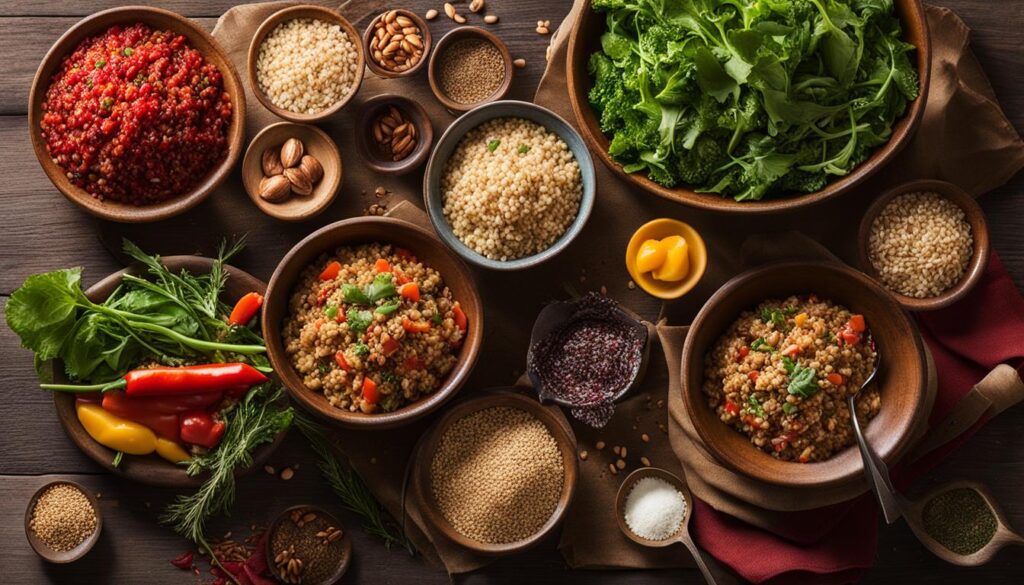
| Meal | Whole Grain Dish |
|---|---|
| Breakfast | Quinoa “Breakfast Salad” |
| Lunch | Wheat Berry and Shredded Cabbage Salad with Buttermilk Dressing |
| Wild Rice, Pear, and Roasted Sweet Potato Salad with Walnuts | |
| Dinner | Veggie Burger |
| Comforting Meatloaf or Casserole |
Exploring Different Whole Grains
When it comes to whole grains, there is a world of flavors and textures to discover. Each grain has its own unique characteristics that can elevate your dishes to new heights of deliciousness. Let’s explore some popular whole grains and their specialty:
Bulgur
Bulgur is a quick and easy whole grain to prepare. It has a nutty flavor and a chewy texture that adds depth to salads, pilafs, and stuffings. With its high fiber content and versatility, it’s a great grain to have in your pantry.
Quinoa
Quinoa is often called a superfood because it is rich in protein and essential amino acids. It has a light, fluffy texture and a slightly nutty taste. Quinoa is a great option for salads, side dishes, or as a substitute for rice or pasta in various recipes.
Farro
Farro is an ancient grain with a nutty flavor and a hearty, chewy texture. It adds a satisfying bite to soups, salads, and risottos. With its versatility, farro can be used in both sweet and savory dishes, making it a delightful addition to your culinary repertoire.
These three grains are just the tip of the iceberg. There are many other whole grains to explore, such as amaranth, barley, millet, and wild rice. Each grain brings its own unique qualities to the table, allowing you to experiment and create delicious meals.
Discover the wonderful world of whole grains and let your taste buds embark on a flavorful journey.
| Whole Grain | Flavor | Texture | Uses |
|---|---|---|---|
| Bulgur | Nutty | Chewy | Salads, pilafs, stuffings |
| Quinoa | Slightly nutty | Light and fluffy | Salads, side dishes, rice substitute |
| Farro | Nutty | Hearty and chewy | Soups, salads, risottos, sweet and savory dishes |
| Amaranth | Slightly sweet | Light and fluffy | Porridge, baked goods, side dishes |
| Barley | Nutty | Chewy | Soups, stews, pilafs, salads |
| Millet | Mild and slightly sweet | Light and fluffy | Porridge, salads, baked goods |
| Wild Rice | Nutty and earthy | Chewy with a slight crunch | Pilafs, salads, stuffings |
Quick and Easy Whole Grain Snacks
Snacking on whole grains is a delicious and nutritious way to satisfy cravings between meals. In my cookbook, you’ll find a dedicated chapter filled with fast and easy whole grain snacks that are sure to please. From flavored popcorn options to irresistible graham cracker treats, these snacks are perfect for enjoying at home or on the go.
One of my favorite guilt-free snacks is the Savory Oatmeal Cookies with Cheddar. These savory cookies provide all the pleasure of a traditional cookie but with the added goodness of whole grains. Packed with cheesy flavor and a satisfying crunch, they are the perfect snack to keep you energized throughout the day.
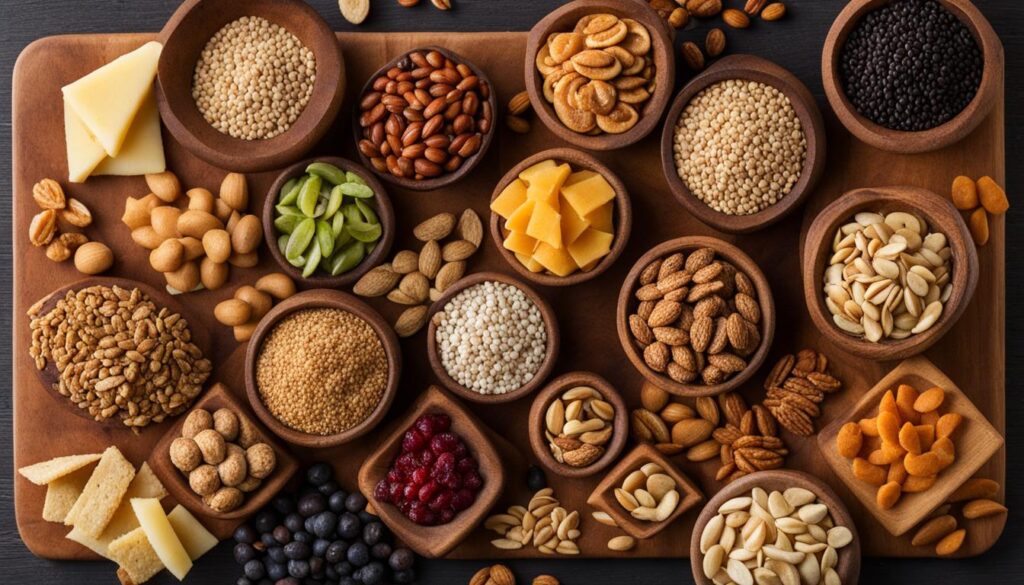
Satisfy your cravings with delicious and nutritious whole grain snacks.
The Gourmet Side of Whole Grains
Whole grains are not just healthy – they can also be gourmet. In the book “Whole Grain Mains” by Mark Scarborough and Bruce Weinstein, you’ll find a collection of hearty and delicious whole grain recipes that elevate whole grains to gourmet status. From Italian Style Black Quinoa and Spinach Summer Rolls to Sweet Potato, Kale, and Chickpea Soup with Farro, these recipes showcase the versatility and gourmet potential of whole grains.
Gourmet Whole Grain Recipes
Experience the exquisite flavors and textures of these gourmet whole grain recipes:
- Italian Style Black Quinoa and Spinach Summer Rolls
- Sweet Potato, Kale, and Chickpea Soup with Farro
- Wild Mushroom Risotto with Barley
- Spiced Lentil and Bulgur Pilaf
These gourmet dishes demonstrate that whole grains can be both nutritious and incredibly satisfying. By incorporating whole grains into your cooking repertoire, you can elevate your meals to a whole new level of gourmet indulgence.
The Ease of Whole Grain Cooking
Cooking with whole grains is easier than you might think. With the right recipes and techniques, you can create flavorful dishes in no time. My cookbook, “The Whole Grain Promise,” focuses on providing easy and accessible recipes that make incorporating whole grains into your diet a breeze. From simple baking mixes for pancakes and biscuits to no-knead bread and quick side dishes, you’ll find a variety of recipes that fit your busy lifestyle.
Simple Baking Mixes
If you’re looking for a quick and convenient way to incorporate whole grains into your breakfast routine, try my easy baking mixes. These pre-prepared mixes take the hassle out of measuring and mixing, so you can enjoy fluffy pancakes and tender biscuits in no time. Simply add wet ingredients, like milk and eggs, to the mix, and you’ll have a wholesome and delicious breakfast in minutes.
No-Knead Bread
Baking your own bread may seem intimidating, but with my no-knead bread recipe, it’s as easy as can be. This no-fuss method eliminates the need for kneading and simplifies the bread-making process. Just mix the ingredients together, let the dough rise overnight, and bake the next day. The result is a crusty, artisan-style bread with a soft and chewy interior, perfect for sandwiches or enjoying with a bowl of soup.
Quick Side Dishes
Looking for a nutritious and flavorful side dish that comes together in a flash? My cookbook includes a variety of quick whole grain side dishes that pair perfectly with any main course. From quinoa salad with fresh herbs to bulgur pilaf with roasted vegetables, these recipes are packed with vibrant flavors and hearty textures, making them a hit at any meal.
With “The Whole Grain Promise,” you don’t have to be a kitchen expert to cook with whole grains. These easy and accessible recipes will guide you through the process, ensuring that you can enjoy the benefits of whole grains without the hassle. So why wait? Start incorporating whole grains into your cooking today and taste the difference.
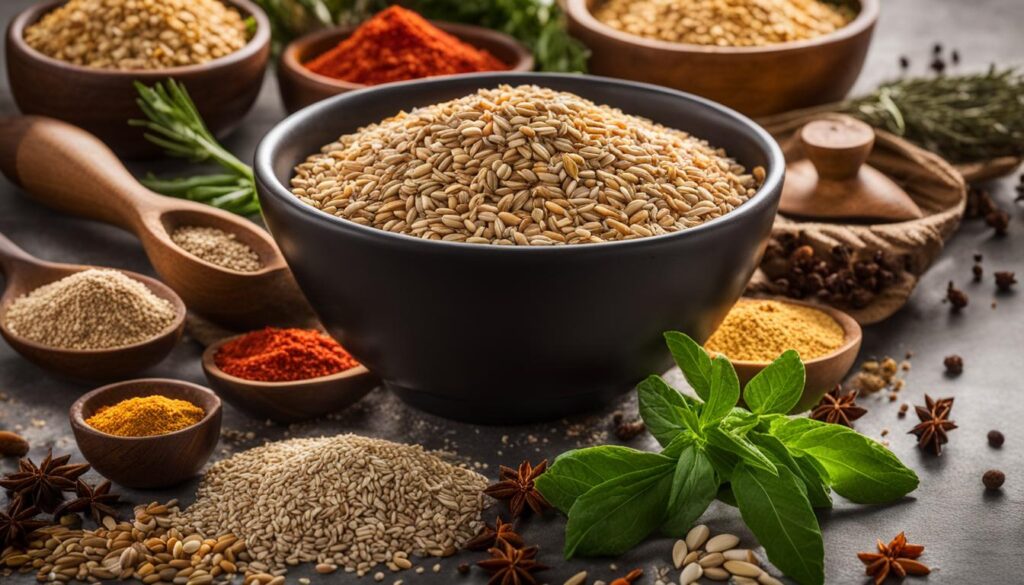
| Benefits of Cooking with Whole Grains | Easy Whole Grain Recipes from “The Whole Grain Promise” |
|---|---|
| High in fiber, which aids digestion and promotes a feeling of fullness | Peachy Yogurt Coffeecake |
| Rich in vitamins and minerals for overall health and well-being | Mexican Tortilla Soup with Shrimp |
| Helps reduce the risk of heart disease and aids in weight management | Wheat Berry and Shredded Cabbage Salad with Buttermilk Dressing |
| Offers a wide range of flavors and textures to keep your meals exciting | Wild Rice, Pear, and Roasted Sweet Potato Salad with Walnuts |
Whole Grains for a Plant-Based Diet
Whole grains are a staple in a plant-based diet. They provide essential nutrients and contribute to a well-rounded meal plan. Whether you’re following a vegetarian or vegan diet or simply looking to incorporate more plant-based meals into your routine, whole grains are a valuable addition. They offer a satisfying and nourishing base for a variety of plant-based dishes.
In addition to being rich in fiber, whole grains are a great source of complex carbohydrates, proteins, and essential minerals. They can help you meet your daily nutritional requirements while adding texture and flavor to your meals.
Whole grains provide a wholesome foundation for plant-based meals, offering a wide range of flavors and textures that can satisfy even the most discerning palates.
With their versatility, whole grains can be incorporated into a variety of plant-based dishes. Use them as the base of nourishing grain bowls, salads, and stir-fries. Combine them with beans and legumes for hearty plant-based burgers or meatless meatballs. With whole grains, the possibilities are endless.
Here are some popular whole grains that are perfect for a plant-based diet:
- Brown rice: a versatile grain that pairs well with vegetables, beans, and tofu.
- Quinoa: a complete protein grain that cooks quickly and is perfect for salads and bowls.
- Barley: a nutty grain that adds texture and flavor to soups and stews.
- Buckwheat: a gluten-free grain that can be used in pancakes, porridge, and side dishes.
Whole grains not only provide essential nutrients but also contribute to the overall sustainability of a plant-based diet. By incorporating whole grains into your meals, you are supporting environmentally friendly food choices and reducing your carbon footprint.
So, whether you’re a dedicated vegan or simply looking to include more plant-based options into your diet, whole grains are an excellent choice. They offer a nutritious and delicious foundation for a well-balanced and sustainable plant-based lifestyle.
Exploring Whole Grain Varieties
When it comes to incorporating whole grains into your diet, there is a vast array of options to choose from. Each whole grain variety offers its own unique characteristics, flavors, and textures that can add diversity and excitement to your meals. From familiar grains like whole wheat and brown rice to lesser-known and ancient grains like teff and amaranth, the possibilities are endless.
Exploring different whole grain varieties is a great way to expand your culinary horizons and discover new flavors that you may have never experienced before. Don’t be afraid to step out of your comfort zone and incorporate new grains into your meals. You might just stumble upon a new favorite that will become a staple in your kitchen.
To help you get started on your whole grain exploration journey, here is a list of some popular whole grain varieties:
- Whole Wheat
- Brown Rice
- Quinoa
- Barley
- Buckwheat
- Millet
- Amaranth
- Teff
Note: This is not an exhaustive list, and there are many other whole grain varieties available.
Each whole grain variety has its own unique nutritional profile and cooking methods. Some grains may be quick-cooking, while others may require longer cooking times. Experimenting with different grains allows you to discover their distinct flavors and textures, making your meals more interesting and enjoyable.
Benefits of Exploring Whole Grain Varieties
Exploring different whole grain varieties not only adds culinary excitement to your meals but also provides a range of health benefits. Here are some potential advantages of incorporating diverse whole grain varieties into your diet:
- Increased nutrient intake: Different grains offer varying levels of nutrients, such as dietary fiber, vitamins, and minerals. By exploring various whole grain varieties, you can broaden your nutrient intake and ensure that you get a wide range of essential nutrients.
- Enhanced flavor profiles: Each whole grain variety has its own unique taste and texture, which can elevate the flavors of your dishes. Whether you prefer nutty, earthy, or chewy grains, experimenting with different varieties allows you to discover new and exciting flavor combinations.
- Improved dietary diversity: Consuming a diverse range of whole grains helps ensure a balanced and varied diet. The more diverse your diet, the greater your chances of consuming a wide range of nutrients and enjoying optimal health.
By exploring different whole grain varieties, you not only introduce new flavors and textures to your meals but also take advantage of the nutritional benefits offered by each grain. Don’t hesitate to get creative in the kitchen and experiment with different whole grains to discover your favorites.
Remember, whole grains are a fantastic addition to any diet. They provide essential nutrients, dietary fiber, and contribute to a healthy lifestyle. So, why not start exploring the wonderful world of whole grain varieties today?
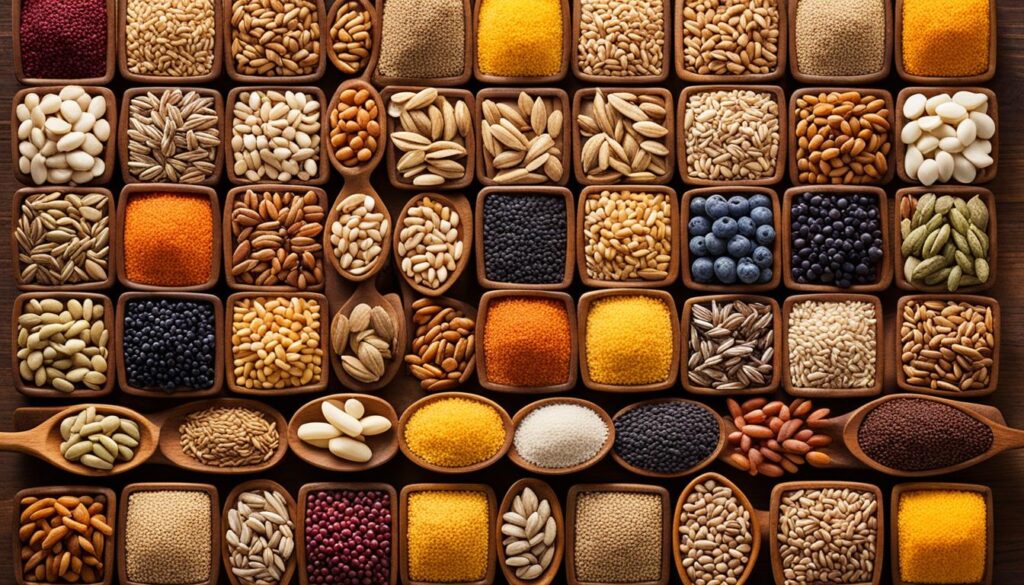
Comparative Table of Whole Grain Varieties
| Whole Grain Variety | Taste | Texture | Nutritional Benefits |
|---|---|---|---|
| Whole Wheat | Nutty, slightly sweet | Chewy | Good source of dietary fiber, B vitamins, and minerals |
| Brown Rice | Earthy, nutty | Firm and slightly chewy | Rich in fiber, antioxidants, and essential minerals |
| Quinoa | Mild, nutty | Light and fluffy | Complete protein source, high in fiber, and rich in minerals |
| Barley | Nutty, slightly sweet | Chewy | Excellent source of fiber, rich in antioxidants, and supports heart health |
| Buckwheat | Earthy, nutty | Soft with a slightly crunchy texture | Rich in essential amino acids, high in dietary fiber, and gluten-free |
| Millet | Mild, slightly nutty | Light and fluffy | Good source of fiber, B vitamins, and minerals |
| Amaranth | Earthy, nutty, slightly sweet | Tender with a slight crunch | High in protein, dietary fiber, and essential minerals |
| Teff | Earthy, slightly nutty | Tiny and soft with a delicate texture | Packed with calcium, iron, and other essential nutrients |
The Future of Whole Grains
Whole grains have stood the test of time and remain an integral part of human diets. However, their importance is growing in today’s health-conscious society. As more people become aware of the remarkable health benefits and culinary potential of whole grains, their inclusion in everyday meals is expected to increase significantly.
Researchers and innovators in the food industry are continuously exploring new ways to incorporate whole grains into our diets. This dedication to advancing our understanding of whole grains and their nutritional value paves the way for exciting developments in the world of food. With ongoing research, we can look forward to even more delicious and creative whole grain recipes in the future.
“Whole grains are the key to a healthier and more sustainable food future. By incorporating them into our lives, we can transform our well-being and impact the planet positively.”
– Food industry expert
In the coming years, we can expect to see an array of innovative whole grain products and dishes that cater to different tastes and dietary needs. These advancements will help promote whole grains as a staple component of a balanced and nutritious diet.
Benefits of Whole Grains: Health and Sustainability
The future of whole grains rests not only on their numerous health benefits but also on their potential to contribute to a sustainable food system. Whole grains have a lower environmental impact than refined grains and play a crucial role in reducing food waste, conserving natural resources, and supporting local farmers.
Considering their nutritional value and positive environmental impact, it is evident that whole grains are here to stay. Embracing whole grains in our daily cooking not only promotes our well-being but also contributes to a healthier planet.
| Health Benefits | Sustainability Impact |
|---|---|
|
|
By making whole grains a prominent part of our diets, we not only improve our own health but also contribute to a more sustainable and resilient food system for future generations.
| Health Benefits | Sustainability Impact |
|---|---|
|
|
Conclusion
Whole grains are not just a passing fad – they are an integral part of a healthy and flavorful diet. By embracing whole grains and incorporating them into our meals, we can enjoy a wide array of delicious dishes while reaping the numerous health benefits they offer. Whether it’s the fiber-rich goodness of oats, the protein-packed punch of quinoa, or the nutty flavor of brown rice, whole grains provide essential nutrients and contribute to overall well-being.
With the accessibility of whole grain recipes and a variety of options to choose from, now is the perfect time to start celebrating whole grains in our everyday cooking. From breakfast to dinner, there are endless possibilities to explore. Whether you’re whipping up a wholesome whole grain salad, baking a batch of hearty bread, or creating a plant-based grain bowl, the versatility of whole grains ensures that there’s something for everyone.
So let’s make a conscious effort to incorporate whole grains into our meals and enjoy the incredible flavors and health benefits they bring. With each bite of whole grain goodness, we’re taking a step towards a healthier, more vibrant lifestyle. Don’t wait to start reaping the rewards of whole grains – let’s celebrate their deliciousness and nourish our bodies one grain at a time.
FAQ
Are whole grains delicious and healthy?
Yes, whole grains are not only delicious but also offer numerous health benefits. They are rich in fiber, vitamins, and minerals, and can reduce the risk of heart disease and aid in weight management.
Do you have any easy whole grain recipes?
Absolutely! In my latest cookbook, “The Whole Grain Promise,” I have curated over 100 easy and fast recipes that make it simple to incorporate whole grains into your diet. From breakfast options to savory dishes, each recipe is designed to be flavorful and nutritious.
Can I incorporate whole grains into every meal?
Yes, whole grains can be incorporated into every meal of the day. From fruity quinoa breakfast salads to hearty wheat berry salads and comforting grain-based dinners, there are endless possibilities for incorporating whole grains into your meals.
What are some popular whole grain varieties to explore?
Some popular whole grain varieties to explore include bulgur, quinoa, and farro. Each grain has its own unique flavor and texture, and trying different varieties can add diversity to your meals.
Are there any quick and easy whole grain snacks?
Yes, my cookbook offers a chapter dedicated to fast and easy whole grain snacks. You can enjoy flavored popcorn options, graham cracker treats, or even savory oatmeal cookies with cheddar.
Can whole grains be gourmet?
Absolutely! The book “Whole Grain Mains” by Mark Scarborough and Bruce Weinstein offers a collection of hearty and delicious whole grain recipes that elevate whole grains to gourmet status. From summer rolls to soups, these recipes showcase the gourmet potential of whole grains.
Is cooking with whole grains easy?
Yes, cooking with whole grains is easier than you might think. My cookbook, “The Whole Grain Promise,” focuses on providing easy and accessible recipes that make incorporating whole grains into your diet a breeze.
Are whole grains suitable for a plant-based diet?
Absolutely! Whole grains are a staple in a plant-based diet, providing essential nutrients and contributing to a well-rounded meal plan. They offer a satisfying and nourishing base for a variety of plant-based dishes.
Can I explore different whole grain varieties?
Yes, there is a wide range of whole grain varieties to choose from, each with its own unique characteristics. From whole wheat and brown rice to lesser-known grains like teff and amaranth, exploring different varieties can add diversity and excitement to your meals.
What does the future hold for whole grains?
As more people become aware of the health benefits and culinary potential of whole grains, their inclusion in everyday meals is expected to increase. Ongoing research and innovation in the food industry will likely result in even more delicious and creative whole grain recipes in the future.

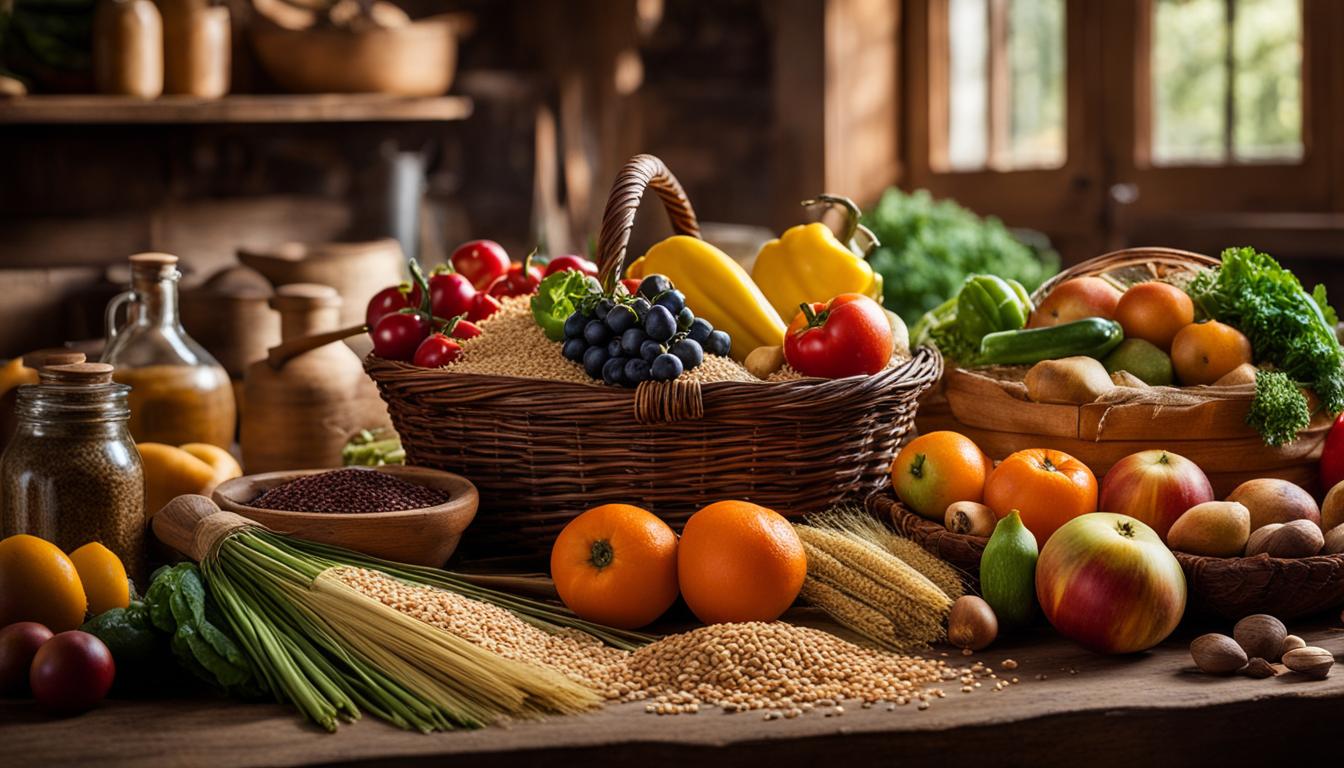
[…] protein, and healthy fats. Opt for whole foods such as eggs, Greek yogurt, fruits, vegetables, and whole grains. For lunch, choose nutrient-dense options like lean proteins, leafy greens, and whole grain […]